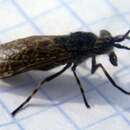en
names in breadcrumbs


Haematopota pluvialis, the common horse fly or notch-horned cleg fly, or simply cleg in Scotland and northern parts of Ireland, is a species belonging to the family Tabanidae subfamily Tabaninae.[1][2][3]
This species is present in most of Europe, in the Near East, and in the eastern Palearctic realm.[4] It mainly lies in heath and moorland, and in spruce forest edge.[5]
Haematopota pluvialis can reach a length of 5–11.5 millimetres (0.20–0.45 in), with a wingspan of 8–10 mm.[5] This species has large compound eyes necessary for locating its prey. They are hairy and brightly colored, with stripes extended over most of the eye. In males, the eyes touch at the centre of the frons and the colored stripes are restricted to the lower part.[6][7]
The first antennal segment is quite bulbous and has a strong sub-apical notch in the female. The thorax is grey, with black longitudinal stripes. The abdomen shows a dark background with a series of lateral pale spots and clearer bands at the end of each black segment. Also the wings have a distinctive pattern, being dark mottled by several clear spots. The legs are black, with yellowish-brown rings.[6][8]
This species is similar to the also common Haematopota crassicornis, but differs from that species in the orange third antennal segment, in the presence of the sub-apical notch and in the overall brown colouration compared to the often grey tinge of crassicornis.[6][7]
These horse flies can be encountered during the daylight hours from late May through late October.[5] The males are harmless and feed on nectar,[7] while the females feed on mammal blood (hematophagy) (hence the Latin name Haematopota pluvialis, literally meaning 'blooddrinker of the rains'), mainly cattle and horses, needing blood for developing eggs. When they bite they inject fluids inhibiting the coagulation of blood, which flows out in such a way that allows the horsefly to lap it. They are also able to bite humans painfully. Females lay their eggs at the base of grass-stems or on the surface of moist soil.
Haematopota pluvialis, the common horse fly or notch-horned cleg fly, or simply cleg in Scotland and northern parts of Ireland, is a species belonging to the family Tabanidae subfamily Tabaninae.